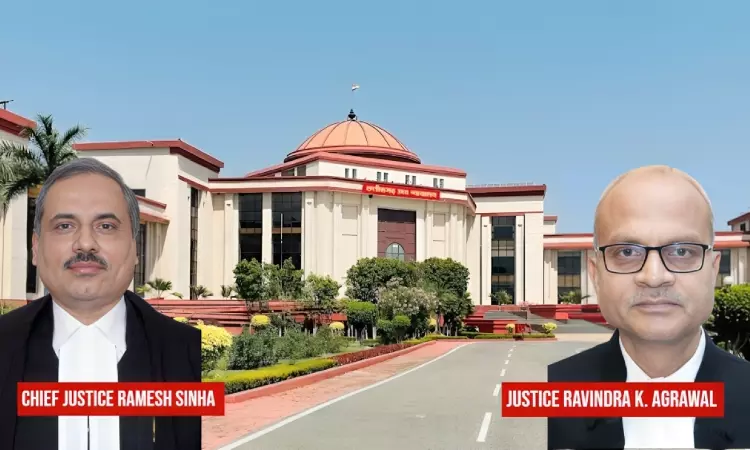- Home
- /
- High Courts
- /
- Chhattisgarh High Court
- /
- Naxal Attacks Are Distinct From...
Naxal Attacks Are Distinct From Ordinary Crimes, They Aim To Overthrow Democracy With Violent Means & Destabilise State: Chhattisgarh HC
Saahas Arora
3 April 2025 8:05 AM
In a significant ruling, the Chhattisgarh High Court has held that naxal attacks are politically and ideologically driven acts of insurgency that aim to destabilise the State and are different from ordinary crimes.Explaining the difference between naxal attacks and ordinary crimes, a Division Bench comprising Chief Justice Ramesh Sinha and Justice Ravindra Kumar Agrawal, stated,"The attacks...
In a significant ruling, the Chhattisgarh High Court has held that naxal attacks are politically and ideologically driven acts of insurgency that aim to destabilise the State and are different from ordinary crimes.
Explaining the difference between naxal attacks and ordinary crimes, a Division Bench comprising Chief Justice Ramesh Sinha and Justice Ravindra Kumar Agrawal, stated,
"The attacks by the Naxals are premeditated, highly organised, and politically motivated, making them far more dangerous than ordinary crimes. Unlike common crimes such as theft, robbery, or even homicide, Naxalite attacks are acts of insurgency aimed at destabilizing the State. These operations involve ambushes, guerrilla warfare tactics, and the use of sophisticated weaponry such as IEDs (Improvised Explosive Devices) and landmines. Security personnel, including the Central Reserve Police Force (CRPF), police, and paramilitary forces, are often the primary targets. These attacks are well-planned and executed with the intent to inflict maximum casualties, weaken the morale of the security forces, and assert control over remote and forested regions.
Naxalites aim to overthrow the democratic system through violent means. Generally, Naxalites operate in remote, forested areas where collecting forensic or material evidence is difficult. Many of their attacks involve IED blasts, ambushes, and guerrilla warfare tactics, making it challenging to identify individual perpetrators. Local villagers, who often witness Naxalite activities, are reluctant to testify due to fear of violent retaliation. Since Naxalites exercise strong control over certain areas, any person cooperating with law enforcement becomes a target, leading to witness intimidation or complete silence. Unlike conventional criminals, Naxalites do not operate under identifiable names or keep proper records. Many of them use aliases, making it difficult for authorities to track their real identities. Hence, often the circumstantial evidences play a key role in convicting and sentencing the accused. Absence of direct evidence cannot automatically lead to a conclusion regarding innocence of the accused persons,” they added.
Background
The Court was dealing with multiple criminal appeals filed under Section 374(2) of CrPC, against an order passed by the Special Judge under NIA Act and First Additional Sessions Judge, North Bastar, Kanker, Chhattisgarh, convicting the appellants under Sections 148, 120B and 302/149 of the Indian Penal Code (“IPC”).
Initially, an FIR was lodged by Smt. Devli Koratia (“the complainant”), wife of one Dadusingh Karotia (“the deceased”). The complainant reported that the deceased was shot dead by an unlawful assembly comprising the appellants who were alleged to be members of the banned terrorist organisation. In the events that led to the murder, the complainant stated that she, her daughter, and the deceased were at home when two persons came with a 12 year old boy in need of bandaging, upon which they were advised to go to the hospital. Later, when the deceased came out of the kitchen, both the persons took out a sharp-edged weapon and started attacking her husband in furtherance of the common object to kill him. Later, they shot him dead and the deceased fell down outside on the road where roughly 10-12 people were standing, including the appellants (Sundar Pudo, Jailal, Jagdu etc.), who left from there raising slogans like “Lal Salaam Zindabad” and the “RSS goons should die like this”.
The police conducted the initial investigation, collected evidence and blood samples from the crime scene and recorded statements from witnesses. Maoist banners and pamphlets were also seized by the police. The case was then received by the Special Court under NIA Act and First Additional Sessions Judge, North Bastar, Kanker (“trial Court”). During the trial, the prosecution examined a total of 35 witnesses and 61 documents. The trial Court, after appreciating oral and documentary evidence available on record, by an order dated 16.01.2026 (“impugned order”), convicted the appellants of the charges levelled against them under Section 148, 120B and 302/149 of IPC.
Aggrieved by the conviction, the appellants approached the High Court.
Stating that the conviction ordered by the trial Court was totally unjustified, the appellants contended that the trial Court had neither appreciated the evidence placed on record nor proved beyond reasonable doubt the offence of the appellants. Further, they argued that the wife of the deceased, who was PW 1 in the trial, had nowhere stated in her deposition that appellants had fired the gunshots which killed her husband and the appellants were merely standing outside the house of the deceased along with other 10-12 persons which cannot be equated with actual commission of the crime. Additionally, it was argued that the conviction was contrary to the rule of prudence as neither the eyewitness evidence was proved nor did any legal evidence conclusively support the prosecution's case.
Contrary to this, the State, supporting the conviction, argued that the prosecution had proved the offence beyond reasonable doubt by leading evidence of clinching nature and the trial Court had considered all incriminating material and circumstances before rightly convicting the appellants.
Thus, the Court was to determine- (i) whether the Trial Court was justified in holding that death of deceased was homicidal in nature, and (ii) whether the Trial Court rightly held that the appellants were authors of the crime
Findings
With respect to the question whether the Trial Court was justified in holding that death of the deceased was homicidal in nature, the Court noted that the postmortem conducted on the body of the deceased highlighted clearly that the cause of death was owing to the head injury and gunshot injury to the chest, both of which were individually and collectively sufficient to cause death in ordinary course of nature. The head injury caused by bullet force impact and all the injuries were antemortem and death of the deceased was homicidal in nature. Affirming the findings of the trial Court, the Court held that the “finding recorded by the trial Court is a finding of fact based on evidence available on record, which is neither perverse nor contrary to record.”
With respect to the question whether the Trial Court rightly held that the appellants were authors of the crime, the Court held that despite contradictions and omissions in the evidence presented by the prosecution witnesses, the evidence of PW-1 duly proved the involvement of the appellants beyond reasonable doubt. PW-1 (wife of the deceased and complainant) was an eyewitness of the incident and had lodged the FIR in which she had specifically mentioned the names of the appellants.
Subsequently, the Court also had to establish whether the appellants were members of an unlawful assembly and whether they actually took part in the crime. For this, the Court delved into an explanation of the application of Section 149 of IPC and observed,
“Section 149 IPC is quite categorical. It says that if an offence is committed by any member of an unlawful assembly in prosecution of the common object of that assembly, or such as the members of that assembly knew to be likely to be committed in prosecution of that object, every person who, at the time of committing of that offence, is a member of the said assembly; is guilty of that offence. Thus, if it is a case of murder under Section 302 IPC, each member of the unlawful assembly would be guilty of committing the offence under Section 302 IPC.”
The Court further explained,
“…Section 149 IPC creates a constructive or vicarious liability of the members of the unlawful assembly for the unlawful acts committed pursuant to the common object by any other member of that assembly. By application of this principle, every member of an unlawful assembly is roped in to be held guilty of the offence committed by any member of that assembly in prosecution of the common object of that assembly. The factum of causing injury or not causing injury would not be relevant when an accused is roped in with the aid of Section 149 IPC.”
The Court noted that with evidence collected by the prosecution and statements and evidence produced by complainant and the witnesses, the prosecution had succeeded in proving beyond reasonable doubt that the deceased was murdered by shooting by an unknown Naxalite accompanied by two other Naxalites. There were 10-12 persons standing at some distance from the spot, which included the accused persons and after the incident of murder, they raised such slogans which showed that the appellants had murdered the deceased alongwith the unknown Naxalites in furtherance of a common object. Conspiring together as members of an unlawful assembly equipped with deadly weapons to commit the common crime in pursuance of their common object, they committed the murder of the deceased.
Upholding the judgment of the trial Court and dismissing the batch of criminal appeals, the Court held,
“…we are of the considered opinion that the prosecution has been successful in proving its case beyond reasonable doubt and the learned trial Court has not committed any legal or factual error in arriving at the finding with regard to the guilt of the appellants/convicts for the offence punishable under Sections 148, 120B and 302/149 of the IPC.”
Case Details:
Case Number: CRA No. 354 of 2024 (and batch)
Case Title: Sunher Pudo v. State of Chhattisgarh (and batch)
Date: 26.03.2025

